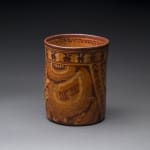Mayan Babilonia Polychrome Cylindrical Vessel, 300 CE - 900 CE
Terracotta
height 18.4 cm
height 7 1/4 in
height 7 1/4 in
PF.5548
The main scene repeated on both sides of the vessel is a representation of a winged mythological creature. This kneeling figure, possibly suspended in midair, appears to be part human,...
The main scene repeated on both sides of the vessel is a representation of a winged mythological creature. This kneeling figure, possibly suspended in midair, appears to be part human, part bird. Flight fascinated the Mayans, as it has all mankind since the birth of time. This is surely one of the earliest depictions of man and bird together as one in Mayan art. Perhaps he is a shaman dressed in a ceremonial costume. Perhaps it is a vision of a powerful deity. This mysterious creature holds his arm outwards, touching the decorative diagonal band that frames the scene. His other hand is held open, just below a series of concentric rings. This could represent an abstracted bird. His wing is elegantly portrayed with intricate plumage. The lines of his feathers are repeated throughout the scene, heightening the kinetics. The graceful curves of the work are opposed to the straighter, angular lines of the figures arms and legs. Series of dots and dashes mark the joins of the plumage. An abstract symbol, possibly a basic glyph, is repeated across a decorative band at the top. The inside lip of the vessel is marked with a row of zigzag patterns. While the symbolism behind this piece has been lost over time, we have finally realized man’s ancient dream to soar like the birds.



